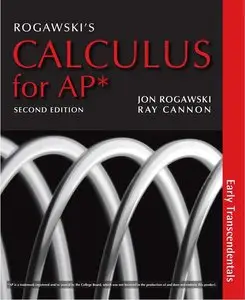Calculus Early Transcendentals (for AP), 2nd edition by John Rogawski, Ray Cannon
English | 2012 | ISBN: 1429250747 | 953 pages | PDF | 73,2 MB
English | 2012 | ISBN: 1429250747 | 953 pages | PDF | 73,2 MB
New to the Second Edition
The new edition of Rogawski’s Calculus for AP* builds on the strengths of the bestselling First Edition by incorporating the author’s own classroom experience, as well as extensive feedback from many in the mathematics community, including adopters, nonusers, reviewers, and students.
Every section has been carefully revised in order to further polish a text that has been enthusiastically recognized for its meticulous pedagogy and its careful balance among the fundamental pillars of calculus instruction: conceptual understanding, skill development, problem solving, and innovative real-world applications.
Enhanced Exercise Sets—withApproximately 25%New and Revised Problems The Second Edition features thousands of newand updated problems. Exercise setsweremeticulously reviewed by users and nonusers to assist the author as he revised this cornerstone feature of the text. Rogawski carefully evaluated and rewrote exercise sets as needed to further refine quality, pacing, coverage, and quantity.
The Second Edition also includes new AP-style multiple-choice and free-response questions (FRQ’s) written by former College BoardAP Calculus Chief Reader, Ray Cannon. These questions, found at the end of each chapter, will help prepare students for the style and structure of questions on the AP exam.
New and LargerVariety ofApplications To show students how calculus directly relates to the real world, the Second Edition features many fresh and creative examples and exercises centered on innovative, contemporary applications from engineering, the life sciences, physical sciences, business, economics, medicine, and the social sciences.
pdated Art Program—with Approximately 15%New Figures Throughout the Second Edition, there are numerous new and updated figures with refined labeling to enhance student understanding. The author takes special care to position the art with the related ex-Preface xi position and provide multiple figures rather than a single one for increased visual support of the concepts.
Key Content Changes Rogawski’s Second Edition includes several content changes in response to feedback from users and reviewers. The key revisions include the following:
• The topic “Limits at Infinity” has been moved up from Chapter 4 to Section 2.7
so all types of limits are introduced together (Chapter 2 Limits).
• Coverage of “Differentials” has been expanded in Section 4.1 and Section 12.4 for
those who wish to emphasize differentials in their approach to Linear Approxima-
tion.
• “L’Hôpital’s Rule” has been moved up so this topic can support the section on
graph sketching (Chapter 4 Applications of the Derivative).
• The section on “Numerical Integration” has been moved to the end of the chapter
after the techniques of integration are presented (Techniques of Integration chapter).
• Asection on “Probability and Integration” was added to allow students to explore
new applications of integration important in the physical sciences as well as in
business and the social sciences (Techniques of Integration chapter).
• A new example addressing the trapezoidal sum has been added to Section 7.8.
• Lagrange error bound for Taylor polynomials in Section 8.4.
• A new example covering the derivative of polar coordinates has been added to
Section 11.4.
Multivariable Calculus: Recognized as especially strong in Rogawski’s Calculus, the multivariable chapter has been meticulously refined to enhance pedagogy and conceptual clarity. Exercise sets have been improved and rebalanced to fully support basic skill development, as well as conceptual and visual understanding



